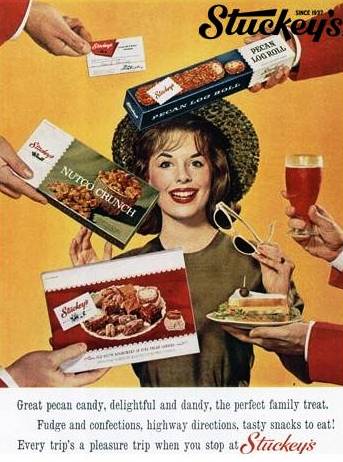
As we know from our history classes, Americans were extremely prosperous in the postwar era after World War II. As a result, they moved to new houses in the suburbs and spent heavily on the latest in modern appliances, furniture, clothing, and automobiles. Along with this prosperity came more leisure time, and since nearly every family had a car, holiday travel turned commonplace. Mass tourism and the idea of vacationing by road became a symbol of what lay ahead for families living in a “great big beautiful tomorrow,” and advertisers took full advantage of this new American optimism, enthusiastically supported by the hospitality and tourism industries.
While magazine publishers saw leisure travel as a way to get their readers to connect with the booming advertising industry, the travel and leisure sectors saw it as a way to promote this new “age of Mobile Man,” as one travel magazine called it. And from motels to roadside stops and vacation destinations, the travel industry took full advantage of it. Nowhere is this idea of traveling for leisure evidenced more than in the pages of magazines, where glossy, colorful advertisements begged readers to “see the USA in your Chevrolet,” and “Relax. Refresh. Refuel.”
That’s right. Through their mass magazine advertising at the time, even Stuckey’s would play an important role in shaping the post-war American tourism industry.
“Every Trip’s a Pleasure Trip …”
Nowhere does Stuckey’s paint this picture of the freedom and excitement of road trips and the optimism of American prosperity than in its print advertisements of the era. In one ad, we see a family in their convertible, dad smiling behind the wheel while mom and the kids excitedly throw their arms in the air as they pass a Stuckey’s sign that reads: “Find Highway Happiness.”
Another ad shows a well-dressed woman being offered everything from drinks and snacks to gas cards and an assortment of Stuckey’s pecan candies, as if she could find anything she wanted at Stuckey’s. Indeed, that was the promise of America, where you could have everything you needed and more.
Commercial Art as Pop Art
The post-war era of America also saw high art become pop art. In fact, many of the famous artists of the era — like Andy Warhol and Mort Künstler — actually began as commercial artists painting advertisements and illustrations for magazines. Many of these artists, unfortunately, remain unnamed — like the artist who painted the commercial art for Stuckey’s Carriage Inn. Even the minimalist illustrations on Stuckey’s matchbooks (another form of advertising) and Stuckey’s black-and-white ads are worthy of hanging on the walls of any modern art gallery.
As a matter of fact, many collectors of Stuckey’s memorabilia have some of these advertisements proudly hanging on their walls at home. Though more “ephemerists” than art collectors, they would argue that their Stuckey’s advertisements are much more beautiful (and perhaps even a more important part of pop culture) than a soup-can lithograph any day.
Kitschy? Maybe, but the kitsch is also part of the fun of a Stuckey’s stop, isn’t it?
Stuckey’s – We’re Making Road Trips Fun Again
Whether your next road trip is by car or by rail, it’s not really a road trip without taking Stuckey’s along. From our world famous Stuckey’s Pecan Log Rolls to our mouthwatering Hunkey Dorey, Stuckey’s has all the road trips snacks you’ll need to get you where you’re going.
For all of the pecany good treats and cool merch you’ll need for your next big road adventure, browse our online store now!
Stuckey’s – We’re Making Road Trips Fun Again!
